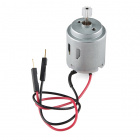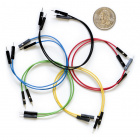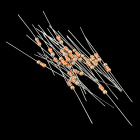Contributors:
 bri_huang
bri_huang Introduction
There are 20 GPIO (General Purpose Input \ Output) pins on the standard Arduino Uno and the SparkFun Redboard. These pins are limited to driving no more than about 40 mA of current. For controlling things like motors, 40 mA is just not enough. A small hobby motor requires at least 100 - 200 mA to spin up. To do this, we need to use a circuit called a transistor amplifier.
This project has been adapted from the Circuit #12 in the SparkFun Inventor's Kit (SIK) v3.3. We've updated the Fritzing diagrams and the code examples to make the connections easier to follow. The SparkFun Inventor's Kit is a great beginners kit to introduce you to the world of physical computing and Arduino.
KIT-13969
**As you may have seen from [our blog post](https://www.sparkfun.com/news/2241), we recently moved our injection mold for SIK…
Retired
Required Materials
We suggest that you start with a full SparkFun Inventor's Kit, but for this tutorial, we are going to be using the SparkFun RedBoard, but you can use any microcontroller development board you like including: Arduino, RedBoard, Photon or Teensy. The concepts covered here are universal to nearly all systems.
Hardware used in this tutorial:
ROB-11696
This is our new Hobby Motor now with a 6mm, 10 tooth, gear to make your basic projects a little simpler to manage. It works w…
DEV-13975
The SparkFun RedBoard combines the simplicity of the UNO's Optiboot bootloader, the stability of the FTDI, and the shield com…
PRT-12002
This is your tried and true white solderless breadboard. It has 2 power buses, 10 columns, and 30 rows - a total of 400 tie i…
PRT-08431
This is a SparkFun exclusive! These are 155mm long, 26 AWG jumpers with male connectors on both ends. Use these to jumper fro…
COM-08588
This is a very common signal diode - 1N4148. Use this for signals up to 200mA of current.
COM-13689
This is the BC337, an NPN silicon BJT (Bipolar Junction Transistor). This little transistor can help in your project by being…
COM-11507
1/6 Watt, +/- 5% tolerance PTH resistors. Commonly used in breadboards and perf boards, these 330Ohm resistors make excellent…
Retired
These parts are all included in the standard SparkFun Inventor's Kit.
Suggested Reading
If you aren’t familiar with the following concepts, we recommend checking out these tutorials before continuing.
How to Use a Breadboard
Welcome to the wonderful world of breadboards. Here we will learn what a breadboard is and how to use one to build your very first circuit.
What is an Arduino?
What is this 'Arduino' thing anyway? This tutorials dives into what an Arduino is and along with Arduino projects and widgets.
Transistors
A crash course in bi-polar junction transistors. Learn how transistors work and in which circuits we use them.







